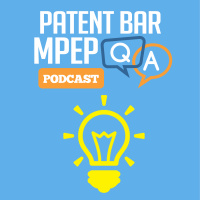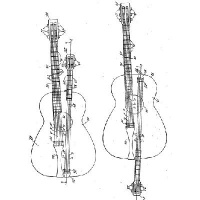Synopsis
Patent Bar Review
Episodes
-
MPEP Q & A 256: What type of applications and proceedings may submit drawings that are not black and white line drawings via EFS-Web?
16/08/2022 Duration: 03minQuestion: What type of applications and proceedings may submit photographs, color drawings, grayscale drawings, and other drawings that are not black and white line drawings via EFS-Web? Answer: Photographs, color drawings, grayscale drawings, and other drawings that are not black and white line drawings may be submitted via EFS-Web in only the following types of applications and proceedings: (1) Nonprovisional design patent applications, including reissue design patent applications; (2) Provisional applications; (3) Nonprovisional utility patent applications, including reissue utility patent applications; (4) U.S. national stage applications; (5) International design applications; (6) Reexamination proceedings for utility or design patents; (7) Supplemental… The post MPEP Q & A 256: What type of applications and proceedings may submit drawings that are not black and white line drawings via EFS-Web? appeared first on Patent Education Series.
-
MPEP Q & A 255: When do members of a Markush group share a ‘single structural similarity’?
02/08/2022 Duration: 02minQuestion: When do members of a Markush group share a ‘single structural similarity’? Answer: Members of a Markush group share a “single structural similarity” when they belong to the same recognized physical or chemical class or to the same art-recognized class (prong 1) and the members of a Markush group share a common function or use when they are disclosed in the specification or known in the art to be functionally equivalent (prong 2). Chapter Details: The answer to this question can be found in chapter 2100 of the MPEP. This chapter covers Patentability. The answer is from the 9th… The post MPEP Q & A 255: When do members of a Markush group share a ‘single structural similarity’? appeared first on Patent Education Series.
-
MPEP Q & A 254: What must a statement under 37 CFR 1.97(e) state?
19/07/2022 Duration: 03minQuestion: What must a statement under 37 CFR 1.97(e) state? Answer: A statement under 37 CFR 1.97(e) must state either; that each item of information contained in the information disclosure statement was first cited in any communication from a foreign patent office in a counterpart foreign application not more than three months prior to the filing of the statement, or that no item of information contained in the information disclosure statement was cited in a communication from a foreign patent office in a counterpart foreign application, and, to the knowledge of the person signing the statement after making reasonable inquiry,… The post MPEP Q & A 254: What must a statement under 37 CFR 1.97(e) state? appeared first on Patent Education Series.
-
MPEP Q & A 253: What must a claim in dependent form contain?
05/07/2022 Duration: 03minQuestion: What must a claim in dependent form contain? Answer: A claim in dependent form shall contain: (i) a reference to a claim previously set forth, and (ii) then specify a further limitation of the subject matter claimed. Chapter Details: The answer to this question can be found in chapter 600 of the MPEP. This chapter covers Parts, Form, and Content of Application. The answer is from the 9th Edition, Revision 10.2019. Depending on future changes to the MPEP, the question and answer may or may not be applicable in later Editions or revisions. Section Summary: This question and answer… The post MPEP Q & A 253: What must a claim in dependent form contain? appeared first on Patent Education Series.
-
MPEP Q & A 252: When the online fee payment in EFS-Web is unavailable, what types of submissions cannot be filed via EFS-Web?
21/06/2022 Duration: 03minQuestion: When the online fee payment in EFS-Web is unavailable, what types of submissions cannot be filed via EFS-Web, since online fee payment must accompany the submission? Answer: When the online fee payment in EFS-Web is unavailable, the following types of submissions cannot be filed via EFS-Web, since online fee payment must accompany the submission: (1) Petitions that require a fee for auto-processing by EFS-Web; (2) Pre-grant publication submissions that require a fee; (3) Third-party preissuance submissions that require a fee; and (4) Web-based Issue Fee Payment. Chapter Details: The answer to this question can be found in chapter 500 of the… The post MPEP Q & A 252: When the online fee payment in EFS-Web is unavailable, what types of submissions cannot be filed via EFS-Web? appeared first on Patent Education Series.
-
MPEP Q & A 251: Benefits of filing a nonprovisional application claiming the benefit of the filing date of the provisional application under 35 U.S.C. 119(e)
07/06/2022 Duration: 03minQuestion: What are the benefits of filing a nonprovisional application claiming the benefit of the filing date of the provisional application under 35 U.S.C. 119(e) rather than requesting conversion? Answer: Claiming the benefit of the provisional application under 35 U.S.C. 119(e) is less expensive and will result in a longer patent term. The procedure requires the filing of a request in the provisional application for the conversion of the provisional application to a nonprovisional application and the required fee. Chapter Details: The answer to this question can be found in chapter 600 of the MPEP. This chapter covers Parts, Form,… The post MPEP Q & A 251: Benefits of filing a nonprovisional application claiming the benefit of the filing date of the provisional application under 35 U.S.C. 119(e) appeared first on Patent Education Series.
-
MPEP Q & A 250: What are examples of situations where ownership must be established?
24/05/2022 Duration: 03minQuestion: What are examples of situations where ownership must be established? Answer: Examples of situations where ownership must be established are when the assignee who is not the applicant: signs a request for status of an application or gives a power to inspect an application; appoints its own registered attorney or agent to prosecute an application; signs a disclaimer; consents to the filing of a reissue application; or signs a Fee Transmittal. Effective September 16, 2012, a juristic entity (e.g., organizational assignee) must be represented by a patent practitioner. Chapter Details: The answer to this question can be found in… The post MPEP Q & A 250: What are examples of situations where ownership must be established? appeared first on Patent Education Series.
-
MPEP Q & A 249: What happens if a claim for foreign priority is presented after the time period set in 37 CFR 1.55?
10/05/2022 Duration: 03minQuestion: What happens if a claim for foreign priority is presented after the time period set in 37 CFR 1.55? Answer: If a claim for foreign priority is presented after the time period set in 37 CFR 1.55, the claim may be accepted if it is accompanied by a grantable petition to accept the unintentionally delayed claim for priority. In addition, a petition to accept an unintentionally delayed claim for foreign priority is necessary to correct any error in a foreign priority claim if the correction is sought after expiration of the time period set forth in 37 CFR 1.55. Chapter Details: The… The post MPEP Q & A 249: What happens if a claim for foreign priority is presented after the time period set in 37 CFR 1.55? appeared first on Patent Education Series.
-
MPEP Q & A 248: What are the enumerated groupings of abstract ideas defined as?
26/04/2022 Duration: 03minQuestion: What are the enumerated groupings of abstract ideas defined as? Answer: The enumerated groupings of abstract ideas are defined as: 1) Mathematical concepts – mathematical relationships, mathematical formulas or equations, mathematical calculations; 2) Certain methods of organizing human activity – fundamental economic principles or practices (including hedging, insurance, mitigating risk); commercial or legal interactions (including agreements in the form of contracts; legal obligations; advertising, marketing or sales activities or behaviors; business relations); managing personal behavior or relationships or interactions between people (including social activities, teaching, and following rules or instructions); and 3) Mental processes – concepts performed in the… The post MPEP Q & A 248: What are the enumerated groupings of abstract ideas defined as? appeared first on Patent Education Series.
-
MPEP Q & A 247: When is a protest considered timely?
12/04/2022 Duration: 03minQuestion: When is a protest considered timely? Answer: A protest is timely if (1) filed prior to the date the application was published under 37 CFR 1.211 or the date a notice of allowance was given or mailed, whichever occurs first, or (2) accompanied by written consent of the applicant and filed prior to the date a notice of allowance was given or mailed in the application. Publication under the Patent Cooperation Treaty (PCT) by the World Intellectual Property Organization (WIPO) of an international application would not trigger the end of the 37 CFR 1.291(b) time period for submitting a protest in a… The post MPEP Q & A 247: When is a protest considered timely? appeared first on Patent Education Series.
-
MPEP Q & A 246: Will the paper application file itself be available to the public for inspection?
29/03/2022 Duration: 04minQuestion: If a published patent application is pending and it is not maintained in the IFW system, will the paper application file itself be available to the public for inspection? Answer: Published applications maintained in the IFW system are available on the USPTO Web site in the public Patent Application Information Retrieval (PAIR) system. If the published patent application is pending and it is not maintained in the IFW system, the paper application file itself will not be available to the public for inspection. Only copies of the application file may be obtained. If the published patent application is abandoned,… The post MPEP Q & A 246: Will the paper application file itself be available to the public for inspection? appeared first on Patent Education Series.
-
MPEP Q & A 245: How is the effective filing date of a claimed invention determined?
15/03/2022 Duration: 03minQuestion: How is the effective filing date of a claimed invention determined? Answer: The effective filing date of a claimed invention is determined on a claim-by-claim basis. Chapter Details: The answer to this question can be found in chapter 2100 of the MPEP. This chapter covers Patentability. The answer is from the 9th Edition, Revision 10.2019. Depending on future changes to the MPEP, the question and answer may or may not be applicable in later Editions or revisions. Section Summary: This question and answer come from section 2133.01 of the MPEP. The following is a brief summary of section 2133.01.… The post MPEP Q & A 245: How is the effective filing date of a claimed invention determined? appeared first on Patent Education Series.
-
MPEP Q & A 244: How can correspondence filed via the Office electronic filing system be signed?
01/03/2022 Duration: 03minQuestion: How can correspondence filed via the Office electronic filing system be signed? Answer: Correspondence filed via the Office electronic filing system may be signed by a graphic representation of a handwritten signature, or a graphic representation of an S-signature. A graphic representation of a handwritten signature may be created by using a stylus pen and/or touch-pad and that all correspondence, except for a notice of appeal filed in the Office must include a signature. Chapter Details: The answer to this question can be found in chapter 500 of the MPEP. This chapter covers the Receipt and Handling of Mail… The post MPEP Q & A 244: How can correspondence filed via the Office electronic filing system be signed? appeared first on Patent Education Series.
-
MPEP Q & A 243: Who may sign the substitute statement for a juristic entity?
15/02/2022 Duration: 03minQuestion: Who may the substitute statement be signed by for a juristic entity? Answer: The answer to this question can be found in chapter 600 of the MPEP. This chapter covers Parts, Form, and Content of Application. The answer is from the 9th Edition, Revision 10.2019. Depending on future changes to the MPEP, the question and answer may or may not be applicable in later Editions or revisions. Chapter Details: For a juristic entity, the substitute statement may be signed by: a person in the organization having apparent authority to sign on behalf of the organization (e.g., an officer), or… The post MPEP Q & A 243: Who may sign the substitute statement for a juristic entity? appeared first on Patent Education Series.
-
MPEP Q & A 242: When will an international application not need a foreign filing license?
01/02/2022 Duration: 03minQuestion: List two reasons why an international application filed with, or forwarded to, the International Bureau would not need a foreign filing license. Answer: An international application filed with, or forwarded to, the International Bureau must have a foreign filing license unless: (1) the invention was not made in the United States; or (2) a U.S. national application on the invention was filed at least six months prior to the filing of the international application, the U.S. national application is not subject to a secrecy order, and the international application does not contain modifications, amendments, or supplements changing the general… The post MPEP Q & A 242: When will an international application not need a foreign filing license? appeared first on Patent Education Series.
-
MPEP Q & A 241: Paying maintenance fee due prior to the issuance of a reissue patent
18/01/2022 Duration: 02minQuestion: If the maintenance fee is due prior to the issuance of a reissue patent, what will paying the maintenance fee maintain? Answer: If the maintenance fee is due prior to the issuance of a reissue patent, the maintenance fee must be paid in the original patent to maintain: (1) the reissue patent in force beyond the end of the applicable grace period and (2) the pendency of any applications for reissue of the original patent. Chapter Details: The answer to this question can be found in chapter 1400 of the MPEP. This chapter covers Correction of Patents. The answer is… The post MPEP Q & A 241: Paying maintenance fee due prior to the issuance of a reissue patent appeared first on Patent Education Series.
-
MPEP Q & A 240: What is an example of a situation that does not define ‘substantial utilities’?
04/01/2022 Duration: 03minQuestion: What is an example of a situation that does not define “substantial utilities”: Answer: The following are examples of situations that do not define “substantial utilities”: (A) Basic research such as studying the properties of the claimed product itself or the mechanisms in which the material is involved; (B) A method of treating an unspecified disease or condition; (C) A method of assaying for or identifying a material that itself has no specific and/or substantial utility; (D) A method of making a material that itself has no specific, substantial, and credible utility; and (E) A claim to an intermediate… The post MPEP Q & A 240: What is an example of a situation that does not define ‘substantial utilities’? appeared first on Patent Education Series.
-
MPEP Q & A 239: Can a patent owner avoid double patenting by disclaiming the earlier patent?
21/12/2021 Duration: 03minQuestion: Can a patent owner avoid double patenting by disclaiming the earlier patent? Answer: “[A] patent owner cannot avoid double patenting by disclaiming the earlier patent.” Chapter Details: The answer to this question can be found in chapter 800 of the MPEP. This chapter covers Restrictions in Applications Filed Under35 U.S.C. 111; Double Patenting. The answer is from the 9th Edition, Revision 10.2019. Depending on future changes to the MPEP, the question and answer may or may not be applicable in later Editions or revisions. Section Summary: This question and answer comes from section 804.02 of the MPEP. The following… The post MPEP Q & A 239: Can a patent owner avoid double patenting by disclaiming the earlier patent? appeared first on Patent Education Series.
-
MPEP Q & A 238: What are examples of laws of nature or natural phenomena?
07/12/2021 Duration: 04minQuestion: List two concepts and products the courts have identified as examples of laws of nature or natural phenomena. Answer: The courts have identified the following concepts and products as examples of laws of nature or natural phenomena: isolated DNA, Ass’n for Molecular Pathology v. Myriad Genetics, Inc.; a cloned farm animal such as a sheep, In re Roslin Institute (Edinburgh); a correlation between variations in non-coding regions of DNA and allele presence in coding regions of DNA, Genetic Techs. Ltd. v. Merial LLC; a correlation that is the consequence of how a certain compound is metabolized by the body, Mayo Collaborative Servs. v.… The post MPEP Q & A 238: What are examples of laws of nature or natural phenomena? appeared first on Patent Education Series.
-
MPEP Q & A 237: What is an example of non-limiting claims not directed to statutory categories?
23/11/2021 Duration: 03minQuestion: Name one example of non-limiting claims not directed to any of the statutory categories. Answer: Non-limiting examples of claims that are not directed to any of the statutory categories include: Products that do not have a physical or tangible form, such as information (often referred to as “data per se”) or a computer program per se (often referred to as “software per se”) when claimed as a product without any structural recitations; Transitory forms of signal transmission (often referred to as “signals per se”), such as a propagating electrical or electromagnetic signal or carrier wave; and Subject matter that… The post MPEP Q & A 237: What is an example of non-limiting claims not directed to statutory categories? appeared first on Patent Education Series.






